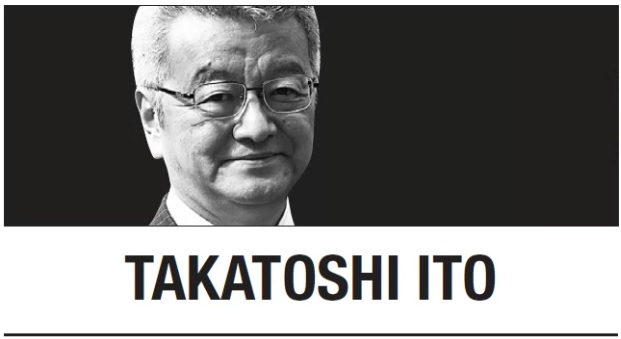[Takatoshi Ito] When will Japan normalize its monetary policy?
By Korea HeraldPublished : Jan. 11, 2024 - 05:38

Japan has had a difficult year so far. On Jan. 1, as Japanese families gathered to celebrate the new year, a powerful earthquake shook the Noto peninsula, causing buildings to collapse and forcing mass evacuations. More than a week later, the death toll -- already in the dozens -- continues to rise, as road damage, heavy rains, and landslides impede rescuers’ ability to reach affected villages.
The next day, a Japan Airlines plane landing at Tokyo’s Haneda airport collided on the runway with a Japanese coast guard aircraft carrying supplies for earthquake refugees. All 367 passengers and 12 crew members were evacuated safely from the burning passenger plane, but five of the six crew members aboard the smaller coast guard aircraft died.
Then, on Jan. 4 -- the first trading day of 2024 -- the Tokyo stock market declined sharply, owing to concerns about the damage from the earthquake. Although the market recovered most of the early-morning losses the same afternoon, the yen has continued to weaken against both the US dollar -- falling from 141 yen to the dollar to 145 yen in 2024 -- and the euro. Investors’ faith in the Bank of Japan’s readiness to normalize policy appears to be waning.
The BOJ currently has three policy tools: the policy (overnight) rate, yield curve control (YCC), and quantitative and qualitative easing (or tightening). The YCC mechanism has been tweaked three times in the last 12 months, and the ceiling for the ten-year bond rate has been raised from 0.25 percent to 0.5 percent, to 1 percent, and then to slightly above 1 percent, as 1 percent became just a “reference,” and operation of the mechanism will be “nimbly conducted” around 1 percent. But the policy rate has stood at minus ten basis points since January 2016, and the BOJ’s balance sheet continues to expand as it purchases yet more Japanese government bonds, albeit at a slow rate.
To avoid hindering economic growth, undermining financial stability, or complicating public debt management, the order in which the three instruments are “tightened” is crucial. The first step is gradually to increase the long-term interest rate -- a process that has already begun with the YCC tweaks. The next step, which markets are awaiting, is to raise the policy rate.
Until recently, the prevailing expectation seemed to be that the BOJ would take this step as early as this month. After all, Japan’s long-moribund inflation rate has been above the 2 percent target for over a year and a half; the economy has been on a steady recovery path since 2021; and 20 percent of listed companies reported record profits in 2023. Add to that widespread labor shortages and a significant yen depreciation -- fueled partly by interest-rate hikes in the eurozone, Britain and the US -- and some have argued that this process should have begun already.
Last month, BOJ Gov. Kazuo Ueda reinforced the impression that the central bank would soon start tightening its policy stance, saying that the situation facing the monetary authority would become “even more challenging” toward the end of 2023 and in 2024. With that, financial markets were thrown into turmoil, as some believed that policy tightening could be initiated as early as the December 18-19 policy board meeting.
On Dec. 25, Ueda emphasized that, while the BOJ is open to tightening, it will manage policy “patiently.” He has also hinted that the BOJ will start hiking interest rates when a substantial wage increase is confirmed. Given that wages in Japan are negotiated by unions each spring the expectation now seems to be that the BOJ will raise rates at its April 25-26 policy board meeting.
Of course, nothing is set in stone. Any decision about policy normalization will depend on the data, especially the wage increase and the inflation rate. Moreover, inflation expectations should be anchored at 2 percent, and Ueda has indicated that, even though inflation is running above 2 percent, he lacks sufficient certainty that the inflation target is being met in a “stable and sustainable” manner. In fact, two-year expected inflation remains below 2 percent, though forecasts released this month will likely say otherwise.
Once the BOJ does start to raise the policy rate, the yield curve -- which reflects the difference between yields on short- and long-term bonds -- will grow steeper. As long as the shift is gradual, this will benefit commercial banks. But a sharp increase in overnight rates could cause turmoil, as shown by the failure of Silicon Valley Bank in the US last year.
When the BOJ introduced negative rates, it established a three-tier system for current accounts, with each tier subject to different interest rates: 0.1 percent, 0 percent, or -0.1 percent. Raising the policy rate to zero will result in either a two-tier system (with zero interest rates for some, and positive rates for others) or a one-tier system with zero interest for all. Raising the policy rate above zero will impose a cash-flow burden on the BOJ.
The trickiest dimension of monetary policy normalization is quantitative tightening. If it is done too quickly, it could adversely affect the Ministry of Finance’s debt management. Moreover, the BOJ would miss an opportunity to replace low-coupon bonds with higher-coupon bonds.
The BOJ has a challenging year ahead. That means markets do, too.
Takatoshi Ito
Takatoshi Ito, a former Japanese deputy vice minister of finance, is a professor at Columbia University and a senior professor at the National Graduate Institute for Policy Studies in Tokyo. -- Ed.
(Project Syndicate)
-
Articles by Korea Herald



















![[Today’s K-pop] Treasure to publish magazine for debut anniversary](http://res.heraldm.com/phpwas/restmb_idxmake.php?idx=642&simg=/content/image/2024/07/26/20240726050551_0.jpg&u=)